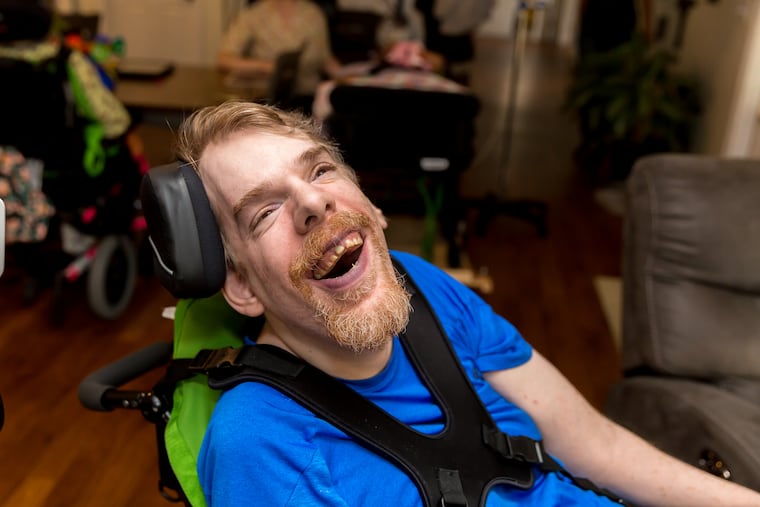Disabled Pennsylvanians need more support
In our state, 12,000 people with intellectual and developmental disabilities are waiting for critical services.

For decades, providers of support and services for the intellectual and developmental disabled community have focused on two goals: building a system where everyone can be served in their community instead of in institutions and stabilizing the workforce that can provide care at home.
But despite years of effort, we are not meeting those goals.
In our state alone, 12,000 people with intellectual and developmental disabilities are waiting for critical services, and provider agencies across the state (and throughout the country) are being crushed by the national workforce crisis.
Clearly, we need new approaches. I believe it’s time to focus on embracing technology and community resources.
All families want their children to succeed in life. While most people with intellectual disabilities live with or are primarily supported by family, more could be. In 2017, 58% of people with intellectual and developmental disabilities lived at home with their families, and only 16% lived in a group home setting. To help more people stay at home, agencies need to replicate the early intervention model in place for young children and extend it to disabled children and adults of all ages.
When a child is identified as not meeting developmental milestones, we have a fantastic system of early intervention that responds to the child’s needs by supporting the family. During that process, families learn to help the child, parents, and other family members grow capable and confident to be the center of the child’s life so that they can be the stewards of their care. But as the child ages, that care typically drops off. We have to replicate this system among the families of disabled children and adults so they remain capable and confident to assume ownership of their loved one’s care as they age. To do that, agencies have to shift the focus from not only supporting a person with intellectual and developmental disabilities but supporting their family as well. If families are capable and empowered, fewer people will require round-the-clock support services.
Many adults with disabilities need help with things like controlling a TV, turning on lights, answering the door, and using kitchen appliances. Technology has advanced to the point where it can do some of that work — such as voice-activated remotes, video doorbell cameras, and smartphone apps that can control kitchen appliances or lights. Other devices respond to dictation or provide alerts and video demonstrations on doing daily activities like brushing your teeth.
For many people, staffing needs can be reduced significantly with this kind of technological support. The technology will require maintenance, but it is cheaper than labor. Installing door sensors, medication dispensers, and tablets that promote independence can reduce the need for direct care. The technology can provide the verbal prompts, alerts, and monitoring to offset the round-the-clock supervision of a staff person. Someone doesn’t have to be present to provide reminders.
If technology does some of the work, the demand for labor is reduced, which lessens the workforce crisis faced by human services providers and helps increase the pay for the staff they need. The increase of enabling and assistive technology for all who need it is also projected to yield more than $10 trillion in economic benefits over the next 55 years through the impact it would have on improving educational outcomes, employability, and productivity. It also would help reduce challenges associated with aging, helping them to work and contribute to society longer.
Many people with intellectual and developmental disabilities could live largely independently or in lifesharing — where one or two people with disabilities live in the home of someone qualified to care for them, matched together based on mutual interests — with assistive technologies. Both options are lower-cost models of support that require less staffing than group homes.
We need to abandon our reliance on fee-for-service models and move to a model that uses more community resources to include every person with an intellectual and developmental disability. Too often, people with disabilities aren’t given opportunities to build social relationships outside of their support networks of staff, clinicians, and family members.
» READ MORE: Disabled kids like my daughter deserve summer fun, too
By investing more time and energy into building external community circles of support through other nonprofits, retirement groups, and volunteer entities, people with intellectual and developmental disabilities can spend more time building personal relationships with those in their neighborhoods. While creating a vetted circle of community support, human services providers can once again offset their staffing demands with certified volunteers interested in cultivating friendships with people with disabilities over shared interests, instead of required job responsibilities.
At the end of the day, all human services providers want to provide the support and services that will empower people with intellectual and developmental disabilities to live full lives. Providers should empower those who care for them — whether family members or direct care personnel — to achieve the same goal.
Marian Baldini is the president and CEO of KenCrest, a human services provider that serves 12,500 people throughout Pennsylvania, Connecticut, and Delaware.